9 Ways to Get rid of Caterpillars Naturally [Dish Detergent, Neem Oil & More]
Caterpillars are the larvae of various insects such as butterflies and moths. They are incredibly destructive to plants as they usually feed directly on the leaves.
Some of them also attack the fruits. Therefore, it’s very important to get rid of caterpillars from your garden, especially if you have a vegetable patch.
While there are many commercial pesticides for killing caterpillars, it’s always better to use natural methods. In this article, we have listed some of the best natural methods for getting rid of caterpillars from plants.
How To Get Rid of Caterpillars on Plants Naturally?
Below are 9 effective ways to get rid of caterpillars naturally. These methods include homemade sprays, natural repellents, several other natural remedies, and homemade solutions to repel caterpillars naturally.
1. Dish detergent homemade spray for caterpillars
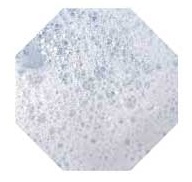
Soap water is toxic to caterpillars, so it is a great method for getting rid of caterpillars from your garden.
When you spray your plants with soapy water, the caterpillars will be coated in the mixture, which will destroy the outer layer of the insects.
The insect will die soon after due to dehydration and starvation. Spraying them with soapy water will also knock them off the plants.
Required Items
- Gardening soap concentrate
- Water
- Garden watering can
Step by Step Process
- In a watering can add 1 gallon of water to 2 teaspoons of soap concentrate. Mix the soap into the water thoroughly before using it.
- Spray the mixture directly on the plants that are affected by the caterpillars.
- Most of the caterpillars should fall off the leaves, but if they don’t, you can remove them manually.
- Spray the mixture over the fallen caterpillars again to drown them.
- Spray the mixture again after 3 to 4 days to get rid of any remaining caterpillars.
Precautions
Caterpillars may hide underneath the leaves as well, so it’s very important to spray the mixture on the underside of the plants as well.
2. Homemade neem oil spray for caterpillars on plants
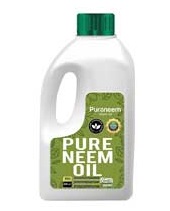
Neem oil is an organic pesticide that is commonly used for killing various insects including caterpillars.
Neem oil is toxic to caterpillars, so when they come in contact with it, the neem oil poisons the insects.
It will kill the caterpillars within a day or two. This is an extremely effective method for getting rid of caterpillars from plants.
Required Items
- Neem oil
- Dish soap
- Water
- Spray bottle
Step by Step Process
- In a spray bottle, add 2 cups of water with 2 teaspoons of neem oil. Add a few drops of dish soap to it.
- Mix the contents of the bottle by shaking it for a few seconds.
- Spray the mixture directly on any caterpillar you find. You can also spray it on the eggs.
- Any caterpillar that comes in contact with the mixture will die within a few hours.
- You can repeat the spraying process after 4 to 5 days if you see any more caterpillars.
Precautions
Neem oil can also kill other beneficial insects in our garden, so don’t overuse it.
3. Diatomaceous Earth Powder
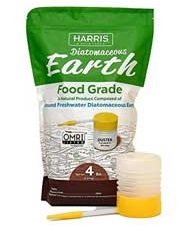
Diatomaceous earth is a white powder that is commonly used for killing a variety of garden insects including caterpillars.
The powder contains microscopic shards that pierce the body of the caterpillar when they walk over it.
Once the powder enters the body of the insect, they become dehydrated and die.
Required Items
- Diatomaceous earth powder
- Applicator
Step by Step Process
- Start by identifying the plants that have been affected by the caterpillars.
- Use the applicator to dust the diatomaceous earth powder on the affected plants. You can dust the powder on the caterpillars directly.
- Do not forget to dust the underside of the leaves, as caterpillars often hide there.
- Any caterpillar
Precautions
You must re-apply the powder if it washes off after rain or due to overhead watering.
4. Beneficial insects
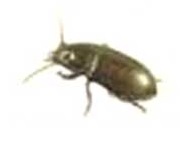
Beneficial insects like parasitic wasps are extremely effective at controlling the caterpillar population.
These wasps do not attack humans or animals, but they attack caterpillars and lay their eggs on them.
The eggs hatch and parasitize the caterpillars, which eventually kills them. You can find parasitic wasps in your garden from various garden centers.
Required Items
- Parasitic wasps
- Flower plants
Step by Step Process
- Plant various flowering plants before you release parasitic wasps in your garden to encourage them.
- Release 20 parasitic wasps in your garden when you start seeing small caterpillars.
- The wasps will lay eggs on the caterpillars almost immediately. The eggs will hatch and kill the caterpillar within 2 to 3 weeks.
Precautions
Do not use any insecticide after releasing parasitic wasps in your garden. Doing so may kill the wasps.
5. BT (Bacillus Thuringiensis)
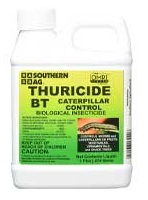
Bacillus thuringiensis or BT is a soil bacteria that is highly toxic to some insects including caterpillars.
The bacteria produce a certain protein that is highly toxic to the caterpillars. Hence, when the caterpillars are infected by the bacteria, they will die within the next 5 to 6 days.
This is a highly effective method for getting rid of caterpillars from your plants.
Required Items
- Bacillus thuringiensis concentrate
- Water
- Garden spray can
Step by Step Process
- In a spray can add the appropriate amount of BT concentrate and water. Mix them thoroughly.
- Spray the mixture on the caterpillars directly. You can also spray the underside of the plants to make sure that the caterpillars cannot hide there.
- Within 5 to 6 days, the caterpillars will die. Re-apply the mixture if you continue seeing caterpillars on the plants.
Precautions
Always follow the instructions on the packaging to ensure the right concentration of BT.
6. Cayenne pepper spray
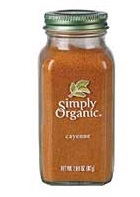
Cayenne pepper is commonly used as a homemade insect repellent.
The active compound in cayenne pepper called capsaicin interacts with the nervous system of the insects that come in contact with it.
So, when you spray cayenne pepper on caterpillars, they will be highly irritated. Some of the caterpillars will die, while others will go away from the plant.
Required Items
- Cayenne pepper
- Dish soap
- Water
- Spray bottle
Step by Step Process
- In a spray bottle, add 1 cup of water with 2 teaspoons of cayenne pepper. Add a few drops of dish soap to it. Shake the bottle to mix the powder into the water.
- Spray the mixture directly on the caterpillars, coating them in the mixture. They will start to move away from the plant immediately.
- Spray the mixture again after 3 to 4 days if you see any remaining caterpillars on the plants.
Precautions
The spray will only work if the insect comes in direct contact with the spray. So, you must take the time to spray it directly on the insects.
7. Homemade spray for caterpillars using vinegar
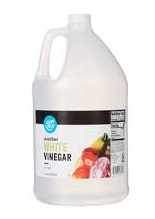
Vinegar is an acid, so it can easily work as an insecticide in your garden.
If you spray a vinegar mixture on caterpillars, it will interact with their outer layer, which will kill the insects within a few hours.
This is a very easy yet highly effective method for getting rid of caterpillars from plants.
Required Items
- White vinegar
- Water
- Spray bottle
Step by Step Process
- In a spray bottle combine ½ cup of water and ½ cup of white vinegar, and mix them together.
- Spray the mixture directly on the caterpillars on your plants. Make sure to check the underside of the leaves, as caterpillars often hide there.
- Any caterpillar that comes in contact with the mixture will die within a few hours.
- You can spray the mixture again after 3 to 4 days if there are any remaining caterpillars.
Precautions
Do not use a high concentration of vinegar, as it can kill the leaves on your plant. It is also best to use this method after sunset to reduce the damage to the leaves.
8. Homemade Garlic spray for Caterpillars
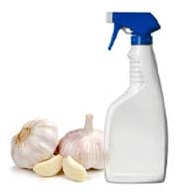
Garlic is commonly used as an insect repellent by homeowners due to its strong and pungent smell.
You can easily make a garlic spray at home using fresh garlic cloves.
This method can easily keep caterpillars away from your plants, and it can prevent them from coming back.
Required Items
- Garlic
- Water
- Spray bottle
Step by Step Process
- Take one garlic and peel off the cloves. Put the cloves along with a cup of water in a blender and blend it until it turns into a thin paste.
- Take the mixture and strain it through a fine cloth. Pour 1 more cup of water into the mixture and pour it into a spray bottle.
- Spray the affected plants with this mixture thoroughly, making sure to coat both the top and bottom of the leaves.
- Any caterpillar on the plant will go away within a few minutes.
- Re-apply the mixture every 3 to 4 days to keep the caterpillars away.
Precautions
This method is effective against smaller infestations, as it does not kill the insect.
9. Burlap trap
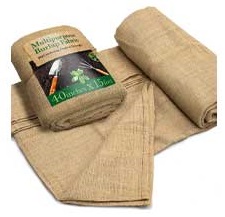
Burlap is a type of thick cloth commonly used to protect plants from frost. However, you can also use it as a caterpillar trap.
When you tie burlap on a plant and spray it with water, it will attract a lot of caterpillars, since the area is moist and cool.
When you have enough caterpillars on them, you can squish them or pick them off to kill them. This method is most effective for smaller caterpillar infestations.
Required Items
- Burlap
- Rope
- Water
Step by Step Process
- Take a 10-inch wide piece of burlap that is enough to cover the stem of a plant.
- Wrap it around the stem and tie it halfway in the middle. Take the top part and fold it over the bottom, creating a gap.
- Wet the burlap with some water and let it sit for 24 hours.
- Caterpillars will climb into the gap because they like a cool and moist area.
- Unwrap the burlap, and squish the caterpillars. You may also pick them off manually if you want.
Precautions
This method is the most effective when the caterpillars are still quite small. It may be harder to catch bigger caterpillars with this method.
Natural Ways to Prevent Caterpillars on Plants
1. Encourage birds in the garden
Birds are natural predators of caterpillars, so encouraging them in your garden will help you get rid of them. You can encourage birds in your garden by hanging up bird feeders.
When the birds come to your garden for the grains, they will also eat up any caterpillar they find. Keeping chickens in your garden is also a great idea because chickens like munching on caterpillars.
2. Plant covers
Plant covers are great for protecting your saplings and young plants. If a caterpillar attacks a small plant, it can destroy it in less than a day.
Using row covers can keep the caterpillars away from the plant until it grows big enough to withstand caterpillar damage.
3. Cardboard
Caterpillars don’t like walking on cardboard because it is rough and dry. So, if you lay cardboard around your plants, it can help repel the caterpillars from the plants.
4. Use companion planting
Companion planting is a method where you plant repellent plants in between your crops to avoid certain pests.
Caterpillars avoid plants that have a strong taste or smell, such as catnip, pepper, peppermint, etc. So, when you plant these plants in between your crops, you can effectively prevent caterpillars in your garden.
5. Avoid night lights
Moths are attracted to lights, so they often fly towards gardens that are illuminated during the night.
These moths will lay eggs in your plants, which will hatch to produce caterpillars. So, it’s always best to avoid any bright lights in the garden after dark to prevent moths.
Final Words:
There are hundreds of types of caterpillars around the world, but almost all of them are destructive to crops and plants. Caterpillars can destroy a plant in only a few days.
So, if you notice any caterpillars in your garden, you must get rid of them immediately. When you use the natural methods mentioned in this article, you can get rid of them very easily.
